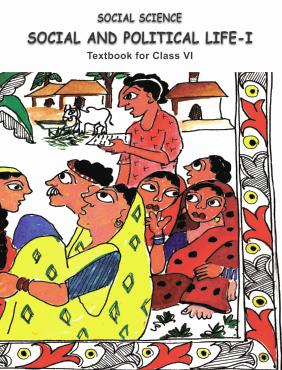Class 6 - Social Science : Social & Political Life I
Chapter 1 : Understanding Diversity

Top Block 1
NCERT Solutions Class 6 Social Science Social And Political Life Understanding Diversity
1. Draw up a list of the different festivals celebrated in your locality. Which of these celebrations are shared by members of different regional and religious communities?
Answers : Festivals shared by different regional and religious communities are :
- Independence Day
- Republic Day
- Gandhi Jayanti
These are our national festivals, so every Indian celebrates them irrespective of region and religion.
2.What do you think living in India with its rich heritage of diversity adds to your life?
Answers : India is a country with a rich heritage of diversity. People here belong to various religions, speak different languages, wear different clothes, eat different things, among other diversities. However, despite all this, we unite together as Indians. We share the same national symbols, national virtues and feelings. Being an Indian gives us the divine idea of ‘sarvadharma sambhava’, which means that we have the virtue of respecting all religions, since all religions are one.
3.Do you think the term “unity in diversity” is an appropriate term to describe India? What do you think Nehru is trying to say about Indian unity in the sentence quoted above from his book “The Discovery of India”?
Answers : Yes, I believe “unity in diversity” is an appropriate term to describe India.
Diversity. India is a large country and people of different parts follow different faiths, speak various languages, wear and eat differently. This shows that India has a diversity spread across its people.
Unity. Despite the diversities, as Indians, we are one. As an Indian, we are no more a Gujarati or a Bengali, we celebrate the national days with equal zeal, we sing the national anthem with the same passion. This shows our unity. Therefore, the phrase “unity in diversity” is justified.
Nehru has written in his book “The Discovery of India”, “It was something deeper and within its fold, the widest tolerance of belief and custom was practised and every variety acknowledged and even encouraged.” He means that when one ponders over it deeply, one finds that India is not only united, but its people also know how to accept other customs and beliefs.
4. Underline the line in the poem sung after the Jallianwalla massacre, which according to you, reflects India’s essential unity.
Answers : Don’t forget the days of blood, O friend ,
In the midst of your happiness remember to shed a tear for us
The hunter has tom away every single flower
Do plant a flower in the desert garden dear friend
Having fallen to bullets we slept in Jallianwalla Bagh
Do light a lamp on this lonely grave O friend
The blood of Hindus and Muslims flows together today
Do soak your robe in this river of blood dear friend
Some rot in jails while others lie in their graves
Do shed a few tears for them O friend.
The underlined line reflects India’s unity. When it came to struggling for freedom of the country, the Hindus and Muslims came together to fight and ‘their blood flows together’.
5. Choose another region in India and do a similar study of the historical and geographical factors that influences the diversity found there. Are these historical and geographical factors connected to each other? How?
Answers : Do yourself.
I. MULTIPLE CHOICE QUESTIONS
Choose the correct option to complete the statements given below:
(i) Samir Do thought Samir Ek did not know……………
(a) English (b) Hindi
(c) Punjabi (d) Urdu.
(ii) Samir Do’s family lived in………...
a) Delhi (b) Meerut
(c) Bihar (d) Jaipur.
(iii) Which of these not an example of inequality?
(a)casting the vote for electing government
(b)belonging to a different religion
(c)speaking one language and not another
(d)earning money.
(iv) Which of these is not a reason for diversify?
(a)history of a region
(b)habitat of a person
(v) Ladakh is a desert in the state of…………….
(a) Kerala (b) Madhya Pradesh
(d) Jammu and Kashmir (d) Rajasthan.
Answers : (i)—(b), (ii)—(b), (iii)—(a), (iv)—(d), (v)—(c).
II.FILL IN THE BLANKS
Fill in the blanks with appropriate words to complete each sentence.
(i) The caste system is a form of……………
(ii)Inequality comes when a person does not have access to…………. and…………..
(iii) A country’s customs, religions, arts and history constitute its ……………..
(iv) People travelled in search of…………..
(v) When people travel to other places, ……….. of cultures takes place.
(vi)Habitat is associated with the ………. one lives in.
(vii)Both Kerala and Ladakh were influenced by……… and………..
(viii) A British general opened fire on a public meeting in………… on April 13, 1919.
(ix) The Discovery of India’ is a book by………..
Answers : (i) inequality (ii) resources, opportunities
(iii) culture (iv) new lands and people
(v) intermixing (vi) geographical area
(vii) Chinese, Arab (viii) Jallianwalla Bagh
(ix) Jawahar Lai Nehru.
III.TRUE/FALSE
State whether each of these sentences is true (T) or false (F).
(i) All Indians share the national anthem.
(ii) All Indians have the same national language.
(iii) All Indians speak the same language.
(iv) Pt. Nehru was the first President of India.
(v) Caste system is an example of diversity.
(vi) Kerala and Ladakh are in different parts of India.
(vii) The geography of Ladakh allows cultivation of spices.
Ans. (i) True, (ii) True, (in) False, (id) False, (v) False, (vi) True, (vii) False.
IV.MATCHING SKILL
Match the items given in column A correctly with those given in column B.
| Column A | Column B |
|---|---|
| 1. Laddakh | A. The Discovery of India |
| 2. Kerala | B. The National Anthem |
| 3. Amritsar | C. Jallianwalla Bagh |
| 4. Rabindranath Tagore | D. Wool |
| 5. Jawaharlal Nehru | E. Spices |
Answers : (i)(d) (ii)(e) (iii)(c) (iv)(b) (v)(a)
Mddle block 1
I.VERY SHORT ANSWER TYPE QUESTIONS
1.Give an example of diversity in India.
Answers : The people of India, living in different parts, speak different languages.9- 1. Give an example of diversity in India.
2. Give an example of unity in diversity among Indians.
Answers : All Indians share the same national pride of having India as their motherland.
3. Why did Samir Do, the paper boy, think the author did not know Hindi?
Answers : Samir Do, the paper boy, thought the author looked like a foreigner, so he could not know Hindi.
4. Why was Samir Do tense?
Answers : Samir Do was tense because riots had broken out in Meerut, where his family lived.
5. Give one example to show why diversity is important in our lives.
Answers : If all had similar lives in aspects of region, religion, opportunities, etc., then writers would lack innovation.
6. Give one way in which Kerala and Ladakh are different.
Answers : Kerala is famous for cultivation of spices. Ladakh is famous for growing wool.
7. What is Ladakh known as?
Answers : Ladakh is known as Little Tibet.
8. Mention the different religions that are practised in Kerala.
Answers : The people of Kerala practice many different religions, such as Judaism, Islam, Christianity, Hinduism and Buddhism.
9. How can you say that the history of Kerala and Ladakh has been similar cultural influences?
Answers : Both regions were influenced by Chinese and Arab traders.
10. How was the Indian flag used during the freedom struggle?
Answers : During the freedom struggle the Indian flag was used as a symbol of protest against the British by people everywhere.
II.SHORT ANSWER TYPE QUESTIONS
1. ‘India is a country of many diversities’. Explain giving examples. [V. Imp.]
Answers : Ope of the special features of India is that it is a country of many diversities. For example.
- We speak different languages, such as Hindi, Punjabi, Gujarati, etc.
- We eat different kinds of food, such as chawal, dal, Razma, idli, dosa, Roti, etc.
- We celebrate different festivals, such as Holi, Diwali, Id, Guru Parv, Christmas, Baishakhi, etc.
- We practise different religions, such as Hinduism, Islam, Shikhism, Christianity, etc.
- We wear different types of clothes, such as saree-blouse, Kurta-pyjama, shirt- pant, etc.
2. India’s diversity has always been recognised as a source of its strength Explain.
Answers : It is a fact that India’s diversity has always been recognised as a source of its strength. It became clear when the country was struggling against the British rule. People from different cultural, religious and regional backgrounds came forward together to oppose the British government in India. They worked together to decide joint actions, they went to jail together and they found different ways to oppose the British. The British thought that they could divide Indians because they were so different and then continue to rule them. But it was their illusion. Although Indians were so different, they were united from within at the question of the British government in India. They were ‘one’ in their battle against the British. They cherished the same goal to banish the British from India as soon as possible.
3. How are history and geography tied in the cultural life of a region? Explain giving examples of Kerala and Ladakh. [V. Imp.]
Answers : Kerala and Ladakh are quite different in terms of their geographical features. It was the geography of Kerala which made the possibility of spice cultivation there. So far Ladakh in concerned, its special geographical location flourished the business of wool collection among the Ladakhi people. The people of Ladakh carefully collect the wool of the sheep and sell it to the traders from Kashmir. The history of both the regions has been affected with similar cultural influences. Both the regions were influenced by Chinese and Arab traders. Thus, we can say the history and geography are often tied in the cultural life of a region.
4. What does diversity add to our lives? [Imp.]
Answers : Diversity is dissimilarity in the way of our life. It is observed in religious functions, in festival, in language, etc. One thing is unique about diversity is that it teaches us to live and adjust ourselves in a broad society. Our Constitution believes in respect to all human beings in a similar way. Diversity makes us tolerant and just. We know how to behave with other people belonging to different caste, creed or culture.
III.LONG ANSWER TYPE QUESTIONS
1. How do we explain diversity? [V. Imp.]
Answers : Diversity is the term that applies to dissimilarities. It may be in language, food, culture, living, religion, etc. India is a unique country where one can observe it extensively. There are a number of festivals, languages, dresses, religions, etc. in India. Still people of India are Indians and they salute the one flag and sing one national anthem. It is unity in diversity.
Diversity occurs when we travel to different parts of the world. Since time immemorial people have been visiting different lands in order to learn something and for trade. They adopted different styles, languages and cultures from all those places.
Diversity also occurs due to geographical variations and natural calamities. For example, Kashmir is a cold place and the temperature goes even below 0°C. Naturally Kashmiri people wear woolen clothes, eat and drink hot food. On the other hand, people in desert areas use different clothes because it is veiy hot there.
2. List three ways in which the different geographical location of Kerala and Ladakh
would influence the following:
- The food people eat
- The clothes they wear
- The work they do.
Answers :
- The food people eat. Ladakh is a desert in the mountains in the eastern part of the Jammu & Kashmir. Veiy little agriculture is possible here. It is therefore people here keep sheep, goats, cows and dzos for their living. They eat meat and milk products like cheese and butter. Kerala is a coastal region. The fertile land and climate are suited to growing rice and a majority of people here eat rice, fish and vegetables.
- The clothes they wear. Ladakhi people wear woollen clothes including pashmina shawls because it is very cold there. The people of Kerala wear cotton clothes.
- The work they do. The people of Ladakh rear sheep for its wool. They carefully collect the wool of the sheep and sell this to traders from Kashmir. The main occupations of the people of Kerala are fishing and farming. People grow rice in huge quantity. They also grow a number of spices like pepper, cloves and cardamoms. It is spices that made this region an attractive place for traders.



